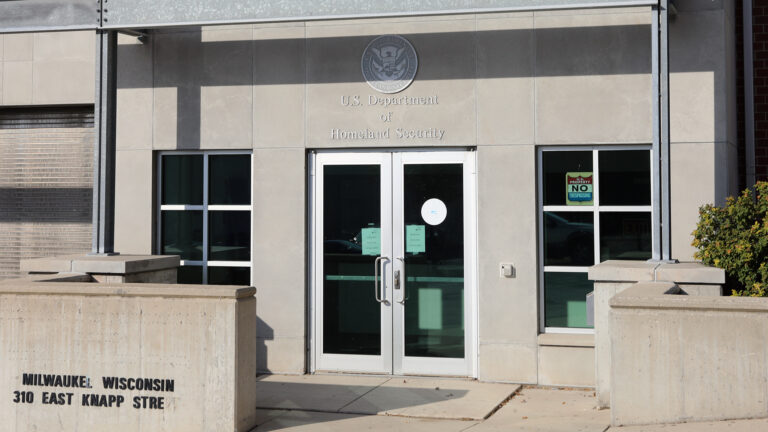A decade of immigrants to Wisconsin and immigration enforcement in 9 charts
Immigration hearing and arrest data from 2015 to 2023 illustrate where new immigrants to Wisconsin originated, where they settled in the state, and how they've fared in immigration court.
Wisconsin Watch
October 6, 2025

A sign marks directions to enter the Dodge County Justice Facility and Dodge County Sheriff's Department on June 6, 2024, in Juneau. The Dodge County Jail at the facility houses immigrants detained by ICE. (Credit: PBS Wisconsin)

This article was originally published by Wisconsin Watch, a nonprofit, nonpartisan newsroom.
Of the roughly 6.6 million immigrants who landed in the federal immigration court system over the past decade, at least 41,000 listed addresses in Wisconsin.
Those immigrants, many of them new arrivals, are now in the spotlight.

A small fraction of cases in federal immigration courts involve immigrants with Wisconsin addresses.
Immigrants with addresses in Wisconsin have accounted for less than 1% of the federal immigration court system’s new caseload since 2015.
More than half of all immigrants who entered the court system during that period settled in just five states.
Roughly 20,000 more immigrants with new court cases listed addresses in neighboring Minnesota compared to Wisconsin.
IA
FL
WI
MI
MN
CA
IL
TX
NY
NJ
Case arranged chronologically be date of the first notice to appear issued to a unique case ID. Address information in immigration court records may be outdated or inaccurate.
Source: U.S. Department of Justice

Federal immigration courts received millions of new cases over the last decade. Only a small fraction involved immigrants with addresses in Wisconsin
Immigrants with addresses in Wisconsin accounted for less than one percent of the federal immigration court system’s new caseload since 2015.
More than half of all immigrants who entered the court system during that period settled in just five states.
Roughly 20,000 more immigrants with new court cases listed addresses in neighboring Minnesota than in Wisconsin during the same period.
IA
FL
WI
MI
MN
CA
IL
TX
NY
NJ
Case arranged chronologically be date of the first notice to appear (NTA) issued to a unique case ID. Address information in immigration court records may be ourdated or inaccurate.
Source: U.S. Department of Justice
The Wisconsin Assembly voted in September to bar local governments or state agencies from subsidizing or reimbursing health care for immigrants who are not “lawfully present” in the United States. One bill sponsor described that proposal as mostly “preemptive,” given that undocumented immigrants are already ineligible for most Wisconsin Medicaid coverage. The ACLU of Wisconsin is asking the state Supreme Court to prohibit local jails from holding immigrant detainees on behalf of federal immigration authorities, even while some law enforcement agencies attempt to wade further into the realm of immigration enforcement.
Many of the human details of those interactions – immigrants’ names, for instance – aren’t recorded in the spreadsheets listing immigration court hearings and U.S. Immigration and Customs Enforcement (ICE) arrests. But the records do provide clues about where new immigrants to Wisconsin came from, where they settled and how they have fared in the immigration court system.
The records also illustrate a 10-year history of shifting immigration enforcement priorities, including the beginning of the Trump administration’s ongoing crackdown.
At least in Wisconsin, immigrants with legal permanent residence outnumber new arrivals. Roughly 21,000 new immigrants in Wisconsin obtained permanent residence between 2015 and 2023: the most recent year for which those data are available. Most were relatives of U.S. citizens, employees of American companies or refugees, though the number of refugees arriving annually in Wisconsin has declined. Of the nearly 7,000 immigrants in Wisconsin who became legal permanent residents in 2023, roughly a quarter were from Mexico.
Those with cases before immigration court, on the other hand, often overstayed visas or entered the country without them, complicating their paths, if any exist, towards legal permanent residency or citizenship. Most came to the U.S. within the past five years, making their way north and registering with the court using a Wisconsin address. Others arrived as children decades ago, first appearing in immigration court records well into their adulthoods.
Unlike federal district courts, immigration courts do not operate within the judicial branch, nor are immigration court judges political appointees subject to Senate confirmation. Instead, the courts operate within the U.S. Department of Justice, hearing cases of noncitizens who the federal government intends to “remove” – in other words, deport. The courts can also consider immigrants’ requests for asylum and other forms of relief.
Wisconsin has no immigration court of its own. The immigration court in Chicago handles most cases involving immigrants with Wisconsin addresses, while a court in Fort Snelling in Minnesota handles a smaller number. But other new arrivals have cases in courts as far away as California and Puerto Rico – an indication of the bewildering range of paths through the federal immigration system.
Immigrants with cases before the courts have the right to an attorney, but the federal government is not generally required to provide one. Unable to afford private attorneys’ fees, many immigrants opt to represent themselves.
Roughly a third of immigrants in Wisconsin who entered the immigration court system over the past decade have been represented by an attorney at some point in their case.
The limited address data available in court records suggests that these new immigrants have settled in major cities and rural communities across Wisconsin, often following jobs in agriculture and manufacturing. Small cities like Abbotsford and Darlington have received more of those recent immigrants per capita than Green Bay, though parts of Milwaukee and Dane County absorbed the largest numbers, both in absolute terms and per capita.
More than half of the new arrivals came to Wisconsin from Mexico and Nicaragua. Wisconsin received roughly 1 in 20 Nicaraguan immigrants to the U.S. over the past decade – behind only Florida, California and Texas, and by far the most disproportionate number in the country relative to the state’s overall share of recent arrivals.
“Most Nicaraguans (in Wisconsin) came from the northern parts of the country and are used to working in agriculture,” said one woman who immigrated to Wisconsin from Nicaragua in 2021. Wisconsin Watch agreed not to name her due to fears of legal repercussions.
A spiraling economy, nationwide protests and a violent police crackdown in 2018 prompted many of her neighbors to leave the country, she said, and word of abundant – and familiar – agricultural jobs drew many to Wisconsin. “By the time I left, only the grandparents remained,” she recalled in Spanish. “There were no more young people, no more children, no more parents.”
Nicaraguans made up the largest share of new immigrants on Milwaukee’s south side, whereas new immigrants from Mexico outnumber those from Nicaragua in the neighboring suburbs.
But the makeup of new immigrants varies substantially between Wisconsin communities. Venezuelans make up the largest share in parts of Dane County, as do Cuban immigrants in parts of Outagamie County, Vietnamese immigrants in Menomonee Falls and Indian immigrants in Oak Creek.
Representation rates vary significantly between immigrant nationalities: Only about 20% of Nicaraguan nationals had representation at some point in their case, compared to roughly 90% of Indian and Chinese nationals.
Not everyone with a case in the immigration court system lacks legal status. Some have obtained Temporary Protected Status (TPS), which currently shields nationals from a dozen countries from deportation, though Secretary of Homeland Security Kristi Noem has moved to terminate those protections for hundreds of thousands of immigrants from Venezuela and Haiti in the coming months. DHS terminated TPS for Nicaraguan nationals in early September.
ICE, a branch of DHS, can move to deport immigrants without a hearing in some cases.
ICE records through late July indicate the agency has arrested roughly 1,700 people in Wisconsin since September 2023. Roughly 45% of those arrested have left the country, either via deportation or “voluntary departure.” Those able to leave via “voluntary departure” avoid adding a removal to their record.
The pace of ICE arrests in Wisconsin is rising during the Trump administration’s nationwide immigration enforcement surge.
In recent months, those arrests have primarily targeted immigrants with criminal convictions or pending criminal charges. The records offer no specifics on the nature of the convictions or charges.
In that regard, Wisconsin is out of step with countrywide trends. ICE data indicates that immigrants with no criminal history made up nearly 30% of arrests nationally in 2025 as of late July, compared to just over 15% of arrests in Wisconsin.
Still, arrests in Wisconsin of immigrants with no criminal history and subsequent deportations are ticking upwards.
Milwaukee immigration attorney Davorin Odrcic says the trend reflects a new set of priorities among immigration enforcement officials.
“There was an unspoken rule,” he said, that if an immigrant was seeking legal status and “not a danger to the community, didn’t have any convictions, ICE would let them go through that process.” Based on one client’s recent arrest and detention, Odrcic believes that unspoken rule has vanished.
While location data on ICE arrests is sparse and often unreliable, the agency’s records point to hundreds of arrests in Wisconsin jails and prisons over the past two years. Those figures will likely grow as Wisconsin sheriffs increasingly sign agreements to help ICE locate and take custody of undocumented immigrants detained in local jails.
Arrest data from the Biden administration included hundreds of records of arrests at an ICE office in downtown Milwaukee, the vast majority of which involved Nicaraguan immigrants with no criminal history. Only a handful of those arrests resulted in deportations, suggesting the immigrants were quickly released. Researchers at the Deportation Data Project, which collects and publishes federal immigration enforcement data, say the “arrests” may simply represent immigrants checking in at the ICE office.
Many of Odrcic’s clients are still required to check in at an ICE office periodically – a visit that has become far more daunting under Trump’s recent crackdown. “It’s a challenging situation,” he said. “I can’t advise you to blow off one of these appointments. I could advise you that there is a possibility of detention. So I just have to leave it at that.”
![]()
 Passport
Passport











Follow Us